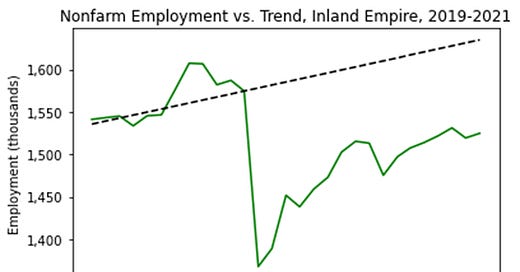Nonfarm employment recovered slightly in August, but the latest statistics still show a major gap between current employment and the pre-pandemic trend – the gap is about 6.7%, meaning our recovery is only about halfway complete. We were doing better back in May or June than we are now.
Most sectors of the economy, aside from Trade, Transportation, and Utilities, are still below their pre-pandemic levels. But the ones that stand out as lagging behind the most are “Leisure and Hospitality”, “Other Services”, and “Government” – i.e., public sector employment. All these sectors are at least 10% down from their pre-pandemic levels and they each constitute at least 5% of the region’s labor market.
The first two of these sectors relate to the environment created by the pandemic. While these industries have made significant gains since earlier this year, some customers continue to perceive restaurants and hotels, as well as other services like haircuts and nail salons, as high-risk environments. Some workers also perceive these places as high-risk occupations, further compromising their recovery.
The one that stands out most is the public sector, which is still down close to 14% from its pre-pandemic levels. Most of the decline in public sector employment is caused by a decline in employment among local schools – industry 931611, or “local government educational services”, the majority of which are teachers as well as other service and administrative support workers. It is no secret that the pandemic severely affected some municipal government budgets, but this statistic shows how grave the issue continues to be.
In fact, seen in this light, private sector employment overall is close to its pre-pandemic peak - once you account for the boom in Trade, Transportation, and Utilities. The same cannot be said for the public sector.



